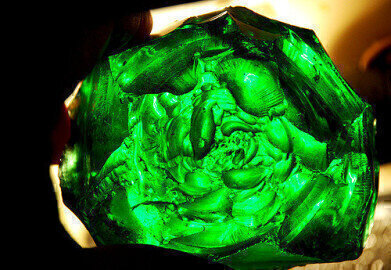News & views
Have Scientists Created Kryptonite?
Mar 18 2016
Chemical element Kr, atomic number 36 and exclusive member of a group of just 18 elements. While krypton itself is a real element, the fictional compound kryptonite made famous in Superman is not. As the mineral form of a radioactive element from Clark Kent’s home planet of Krypton, it’s hailed as the only property that can strip him of his powers. No, scientists haven’t managed to recreate the mythical substance, but they are one step closer.
At the Polish Academy of Sciences, in-house chemists have discovered that krypton may not be as unreactive as originally thought. While it can’t bond with nitrogen in order to create kryptonite crystals, it can bind together with oxygen to form a substance called krypton monoxide.
Breaking down barriers
Defined as a noble gas, krypton’s atoms are protected by a full outer shell of electrons. This makes them highly reluctant to engage in chemical reactions and bond with other matter in order to form molecules. Like fellow noble gas counterparts such as helium and argon, krypton has long been considered an inert element.
In 2003 this theory was challenged, with scientists reporting that when exposed to extreme conditions krypton could be forced into reacting with hydrogen and carbon atoms. The Polish study builds on this research, and maintains that krypton oxides can be formed when the element bonds with oxygen. Intense pressure of 285 gigapascals is required, which results in krypton and oxygen atoms forming a covalent bond. Essentially, this means that a single electron is shared between a pair of atoms.
Genetic algorithms unlock new reactions
While the chemists haven’t observed the reaction first hand, they are adamant that their sophisticated genetic algorithms prove that the formation of krypton-oxygen molecules is a possibility. In the past, the same algorithms have been used to predict a host of other chemical reactions.
As well as extreme pressure, formation is also dependent on a handful of factors, including the number of bonds formed, as well as the spatial arrangement of atoms. The ratio between krypton and oxygen atoms must be 1:1 to produce krypton monoxide, and atoms must be connected in zig-zag chains in order to maintain stability.
Superman may have made krypton famous, but that doesn’t mean he should take all the credit for scientific advancements. As a grass-roots science outreach festival, Soapbox Science brings cutting-edge developments to urban streets, and female prodigies are leading the pack. For more insight into the exciting new concept, ‘Soapbox Science - Bringing Female Scientists to the Streets’ is brimming with information.
Image via Flickr Creative Commons. Photo credits: Dan
Digital Edition
Lab Asia 31.6 Dec 2024
December 2024
Chromatography Articles - Sustainable chromatography: Embracing software for greener methods Mass Spectrometry & Spectroscopy Articles - Solving industry challenges for phosphorus containi...
View all digital editions
Events
Jan 22 2025 Tokyo, Japan
Jan 22 2025 Birmingham, UK
Jan 25 2025 San Diego, CA, USA
Jan 27 2025 Dubai, UAE
Jan 29 2025 Tokyo, Japan



















